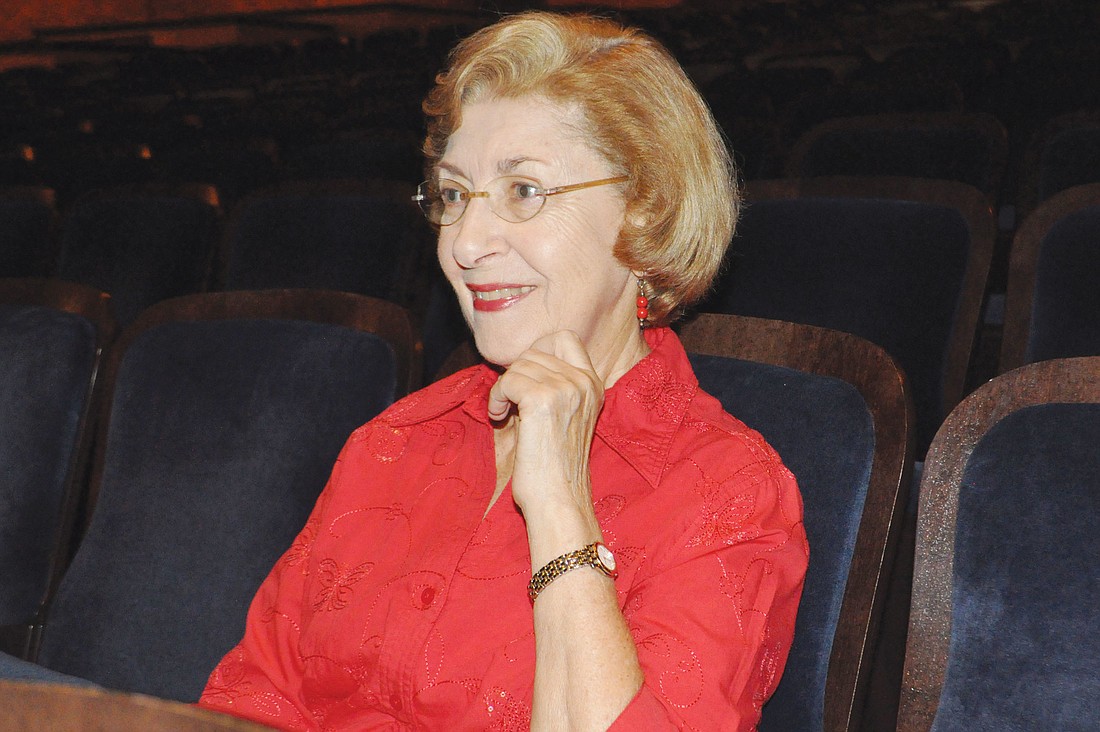- April 19, 2024
-
-
Loading

Loading

Sarasota Opera Guild member and founding member of the National Hearing Loss Association Barbara Chertok can’t wait to reclaim her usual spot: row D at the Sarasota Opera House. Although she looks forward to each new season, the anticipation of this season is a little different, because it’s the first after the installation of a hearing loop system, a technology that wirelessly transfers magnetic signals to hearing aids.
After losing her hearing overnight while studying operatic voice, Chertok, 77, has helped give a voice to the needs of the hearing impaired.
She advocates hearing assistance on a daily basis, and she’s proud to say that more than 50 places in Sarasota now offer hearing loop systems.
Chertok grew up in a poor family outside of Boston. Although her father could not afford to attend the opera, he still exposed his family to its powerful sound. He played two opera records every day: “Lakemé” and “Lucia di Lammermoor.”
“He used to try to sing like a female opera singer,” Chertok laughs.
“That’s how I grew up with opera,” she says. “It became my first love and it’s still my love.” Her favorite opera is “Lucia di Lammermoor.”
As a teenager, Chertok loved singing as much as she did listening. She studied operatic voice for $2 a lesson.
Chertok took music lessons at the Boston Conservatory of Music and then at the New England Conservatory of Music. Eventually, an employment agency led her to a job in advertising. But she continued to sing in the little free time she had.
After a 21-year-old Chertok went to lunch with two of her female coworkers on a sunny day in May 1957, her life changed.
“I was walking back to the office after lunch, and all of the sudden, my balance gave out and I couldn’t walk,” she says.
The hearing in her left ear went out, and a week later, the hearing in her right ear was gone, as well.
When she went to renowned specialist and Harvard neurologist, Dr. Derek Denny-Brown, he told her she had nothing to worry about and that she’d get her hearing back in two to eight weeks.
But Denny-Brown was wrong. He had misdiagnosed her with the herpes virus. It was 35 years later when a doctor at Johns Hopkins discovered the real cause of her hearing loss — she had Cogan’s syndrome, an autoimmune disease.
“If (I had been correctly diagnosed) today, they would have given me massive doses of prednisone, which would have helped me maintain some of the hearing,” she says.
But that wasn’t the case, and Chertok became accustomed to her hearing loss.
“I danced all those years without hearing the music,” she says. “If I was dancing with someone who couldn’t keep the beat, I’d get it from (other dancers) on the floor.”
She’d pick out the winners of operatic vocal competitions with her eyes. She’d watch the symphony on television and could hear the music in her mind.
Her late husband, Benson, had to ask Chertok on a date through her mother because Chertok couldn’t hear him on the phone.
“I kept singing in the bathroom, in the shower, in my car — but I wouldn’t let anyone hear me,” she says.
At that time, Chertok had a hearing aid but had to practically sit on top of a musician to hear a beat of music.
“If I was in a room of 100 people and everyone was talking, I didn’t hear them. I could close my eyes and I would be alone,” she says.
Chertok received her first cochlear implant in 1997. When asked about what it was like hearing opera again for the first time following that implant, she has no words. She got her second cochlear implant 11 years later.
A vocal Chertok was the driving force behind the installation of an infrared system at the Sarasota Opera House a few years ago. Some people don’t like using infrared systems because it requires additional equipment: a receiver with a neck lanyard. But hearing loops only require the flick of a switch on a hearing aid with a T-coil. Chertok continues to work on promoting hearing loops to both the hearing impaired and businesses.
“Everywhere I go, I speak to the managers about hearing assistance. I’ve been doing this for years,” she says.
She likes to keep people in the loop.
Looped theaters in Sarasota
Asolo Repertory Theatre (Cook)
Banyan Theatre Company
Burns Court Cinemas (screens 1 and 3)
Florida Studio Theatre (Keating)
Florida Studio Theatre (Gompertz)
The Glenridge Performing Arts Center
Holley Hall (Sarasota Orchestra)
Neel Performing Arts Center (main)
Neel Performing Arts Center (Howard)
Sarasota Opera House
The Players Theatre
Van Wezel
For a complete list of looped locations in Sarasota and Manatee counties, visit the Hearing Loss Association of Sarasota online at hlas.org. Click on the “Advocacy” tab, then “Let’s Loop SRQ” to find out how hearing loops work and how to use your T-coil.